Altitudinal Gradient Characteristics of Spatial and Temporal Variations of Snowpack in the Changbai Mountain and Their Response to Climate Change
Abstract
:1. Introduction
2. Materials and Methods
2.1. Study Site Description
2.2. Data
2.3. Methods
2.3.1. Modified Mann-Kendall Method
2.3.2. Generalized Additive Model
2.3.3. Spatial Interpolation
3. Results
3.1. Spatial Evolution of Snow Depth in the Changbai Mountains
3.1.1. Interdecadal Variation of Annual Mean Snow Depth
3.1.2. Variation of Monthly Mean Snow Depth
3.2. Interannual Evolution of Snow Depth at Different Altitudes in the Changbai Mountains
3.3. Intra-Annual Evolution of Snow Depth at Different Altitudes in the Changbai Mountains
3.4. The Drivers of Snow Depth Variation in the Changbai Mountains
4. Discussion
4.1. Spatio-Temporal Changes of Snow in the Changbai Mountains
4.2. Climatic Drivers for Changes in Snow Depth
5. Conclusions
- (1)
- Altitude gradient characteristics of the snow distribution were identified in the Changbai Mountains. Snow depth was greater in the higher altitude areas than in the lower elevation areas at different times of the year. Compared with other years, the area with a snow over 70 mm deep increased significantly in the 2010s.
- (2)
- The changing trend in snow depth is not consistent under each altitude gradient. Increasing trends were observed at different altitudes from December to March of the next year during 1960~2018. The most significant change was in April, which presented a significant decreasing trend except for at 600–2378 m.
- (3)
- The Changbai Mountains are a seasonal frozen soil area, and the snow cover duration at different altitudes showed a trend of first increasing and then decreasing from 1960 to 2018. The date of maximum snow depth appeared to become more lagged as the altitude increased. In addition, the spring snowpack melted significantly faster in the 2010s compared with that of the 1960s. Meanwhile, the change was different with increasing altitudes.
- (4)
- Snowpack variation in low-altitude regions is mainly influenced by ET and relative humidity. However, the mean temperature gradually became an important factor, affecting the snow depth variation with an increase in altitude.
Author Contributions
Funding
Institutional Review Board Statement
Informed Consent Statement
Data Availability Statement
Conflicts of Interest
References
- Immerzeel, W.W.; Lutz, A.F.; Andrade, M.; Bahl, A.; Biemans, H.; Bolch, T.; Hyde, S.; Brumby, S.; Davies, B.J.; Elmore, A.C.; et al. Importance and vulnerability of the world’s water towers. Nature 2020, 577, 364–369. [Google Scholar] [CrossRef]
- Viviroli, D.; Dürr, H.H.; Messerli, B.; Meybeck, M.; Weingartner, R. Mountains of the world, water towers for humanity: Typology, mapping, and global significance. Water Resour. Res. 2007, 43, 13–26. [Google Scholar] [CrossRef] [Green Version]
- Fontrodona Bach, A.; Van der Schrier, G.; Melsen, L.A.; Klein Tank, A.M.; Teuling, A.J. Widespread and Accelerated Decrease of Observed Mean and Extreme Snow Depth Over Europe. Geophys. Res. Lett. 2018, 45, 312–319. [Google Scholar] [CrossRef] [Green Version]
- Musselman, K.N.; Clark, M.P.; Liu, C.; Ikeda, K.; Rasmussen, R. Slower snowmelt in a warmer world. Nat. Clim. Chang. 2017, 7, 214–219. [Google Scholar] [CrossRef]
- Kraaijenbrink, P.D.; Stigter, E.E.; Yao, T.; Immerzeel, W.W. Climate change decisive for Asia’s snow meltwater supply. Nat. Clim. Chang. 2021, 11, 591–597. [Google Scholar] [CrossRef]
- Diffenbaugh, N.S.; Scherer, M.; Ashfaq, M. Response of snow-dependent hydrologic extremes to continued global warming. Nat. Clim. Chang. 2013, 3, 379–384. [Google Scholar] [CrossRef] [Green Version]
- Peng, S.; Piao, S.; Ciais, P.; Fang, J.; Wang, X. Change in winter snow depth and its impacts on vegetation in China. Glob. Chang. Biol. 2010, 16, 3004–3013. [Google Scholar] [CrossRef]
- Barnett, T.P.; Adam, J.C.; Lettenmaier, D.P. Potential impacts of a warming climate on water availability in snow-dominated regions. Nature 2005, 438, 303–309. [Google Scholar] [CrossRef]
- Clark, M.P.; Hendrikx, J.; Slater, A.G.; Kavetski, D.; Anderson, B.; Cullen, N.J.; Kerr, T.; Örn Hreinsson, E.; Woods, R.A. Representing spatial variability of snow water equivalent in hydrologic and land-surface models: A review. Water Resour. Res. 2011, 47, 1–23. [Google Scholar] [CrossRef] [Green Version]
- Musselman, K.N.; Lehner, F.; Ikeda, K.; Clark, M.P.; Prein, A.F.; Liu, C.; Barlage, M.; Rasmussen, R. Projected increases and shifts in rain-on-snow flood risk over western North America. Nat. Clim. Chang. 2018, 8, 808–812. [Google Scholar] [CrossRef]
- Biemans, H.; Siderius, C.; Lutz, A.F.; Nepal, S.; Ahmad, B.; Hassan, T.; von Bloh, W.; Wijngaard, R.R.; Wester, P.; Shrestha, A.B.; et al. Importance of snow and glacier meltwater for agriculture on the Indo-Gangetic Plain. Nat. Sustain. 2019, 2, 594–601. [Google Scholar] [CrossRef]
- Arheimer, B.; Donnelly, C.; Lindstrom, G. Regulation of snow-fed rivers affects flow regimes more than climate change. Nat. Commun. 2017, 8, 1–9. [Google Scholar] [CrossRef] [Green Version]
- Qi, P.; Huang, X.; Xu, Y.J.; Li, F.; Wu, Y.; Chang, Z.; Li, H.; Zhang, W.; Jiang, M.; Zhang, G.; et al. Divergent trends of water bodies and their driving factors in a high-latitude water tower, Changbai Mountain. J. Hydrol. 2021, 603, 127094. [Google Scholar] [CrossRef]
- Chi, H.; Sun, G.; Huang, J.; Li, R.; Ren, X.; Ni, W.; Fu, A. Estimation of Forest Aboveground Biomass in Changbai Mountain Region Using ICESat/GLAS and Landsat/TM Data. Remote Sens. 2017, 9, 707. [Google Scholar] [CrossRef] [Green Version]
- Wang, L.; Wang, W.J.; Wu, Z.; Du, H.; Zong, S.; Ma, S. Potential Distribution Shifts of Plant Species under Climate Change in Changbai Mountains, China. Forests 2019, 10, 498. [Google Scholar] [CrossRef] [Green Version]
- Liu, L.; Dong, Y.; Kong, M.; Zhou, J.; Zhao, H.; Wang, Y.; Zhang, M.; Wang, Z. Towards the comprehensive water quality control in Lake Taihu: Correlating chlorphyll a and water quality parameters with generalized additive model. Sci. Total Environ. 2020, 705, 135993. [Google Scholar] [CrossRef]
- Qi, P.; Zhang, G.; Xu, Y.J.; Wu, Y.; Gao, Z. Spatiotemporal changes of reference evapotranspiration in the highest-latitude region of China. Water 2017, 9, 493. [Google Scholar] [CrossRef] [Green Version]
- Qi, P.; Xia, Z.; Zhang, G.; Zhang, W.; Chang, Z. Effects of climate change on agricultural water resource carrying capacity in a high-latitude basin. J. Hydrol. 2021, 597, 126328. [Google Scholar] [CrossRef]
- Feng, M. Water Conservation Mechanism of Typical Vegetation Types in North Slope of Changbai Mountain; Northwest Normal University: Lanzhou, China, 2021. [Google Scholar]
- Li, L.Y.; Ke, C.Q. Analysis of spatiotemporal snow cover variations in Northeast China based on moderate-resolution-imaging spectroradiometer data. J. Appl. Remote Sens. 2014, 8, 1–15. [Google Scholar] [CrossRef]
- Zhang, X.; Zang, S.; Sun, L. Spatial-temporal variation characteristics of snow cover days in Northeast China in the past 40 years and their relationship with climatic factors. Adv. Earth Sci. 2018, 33, 958–968. [Google Scholar]
- Ding, T.; Gao, H. Relationship between winter snow cover days in Northeast China and rainfall near the Yangtze River basin in the following summer. J. Meteorol. Res. 2015, 29, 400–411. [Google Scholar] [CrossRef]
- Han, L.; Tsunekawa, A.; Tsubo, M.; He, C.; Shen, M. Spatial variations in snow cover and seasonally frozen ground over northern China and Mongolia, 1988–2010. Glob. Planet. Chang. 2014, 116, 139–148. [Google Scholar] [CrossRef]
- Li, F.P.; Zhang, G.X.; Xu, Y.J. Assessing Climate Change Impacts on Water Resources in the Songhua River Basin. Water 2016, 8, 420. [Google Scholar] [CrossRef] [Green Version]
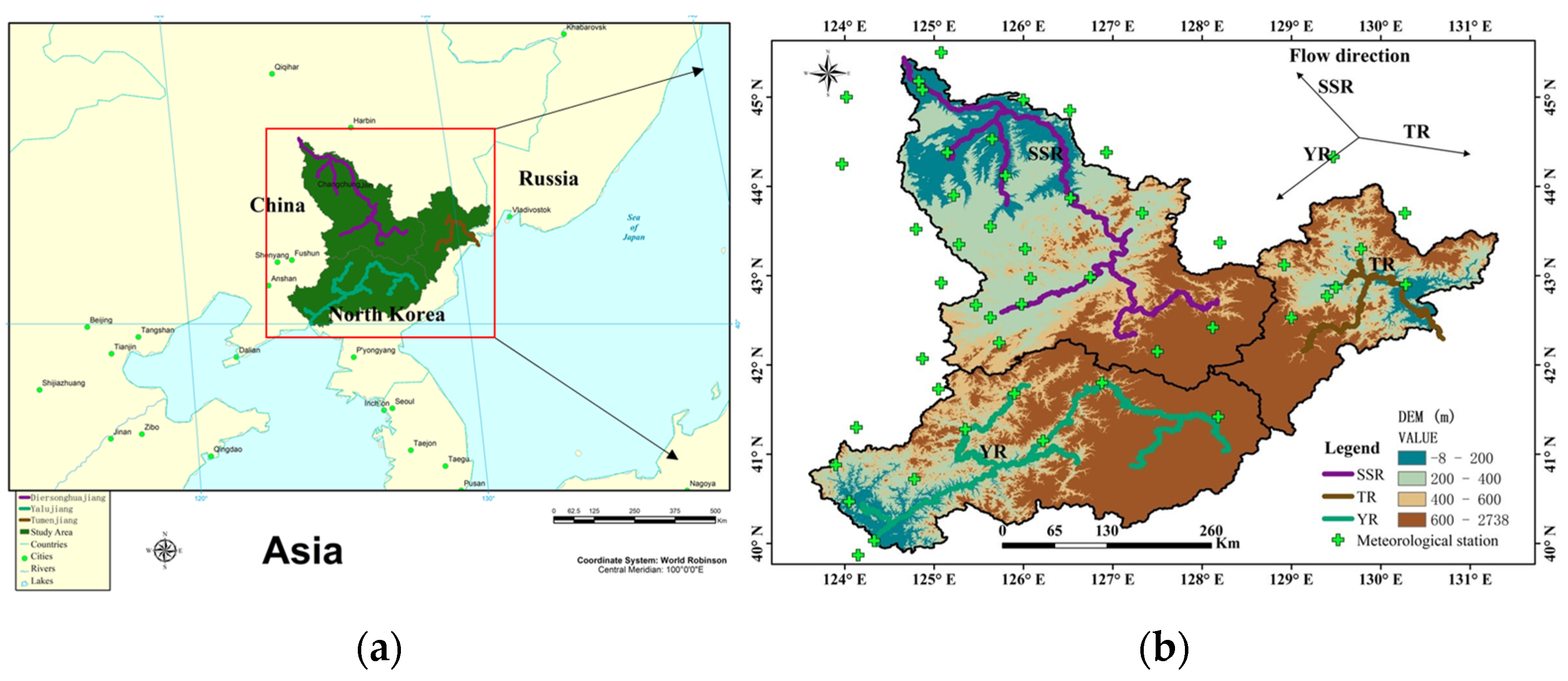
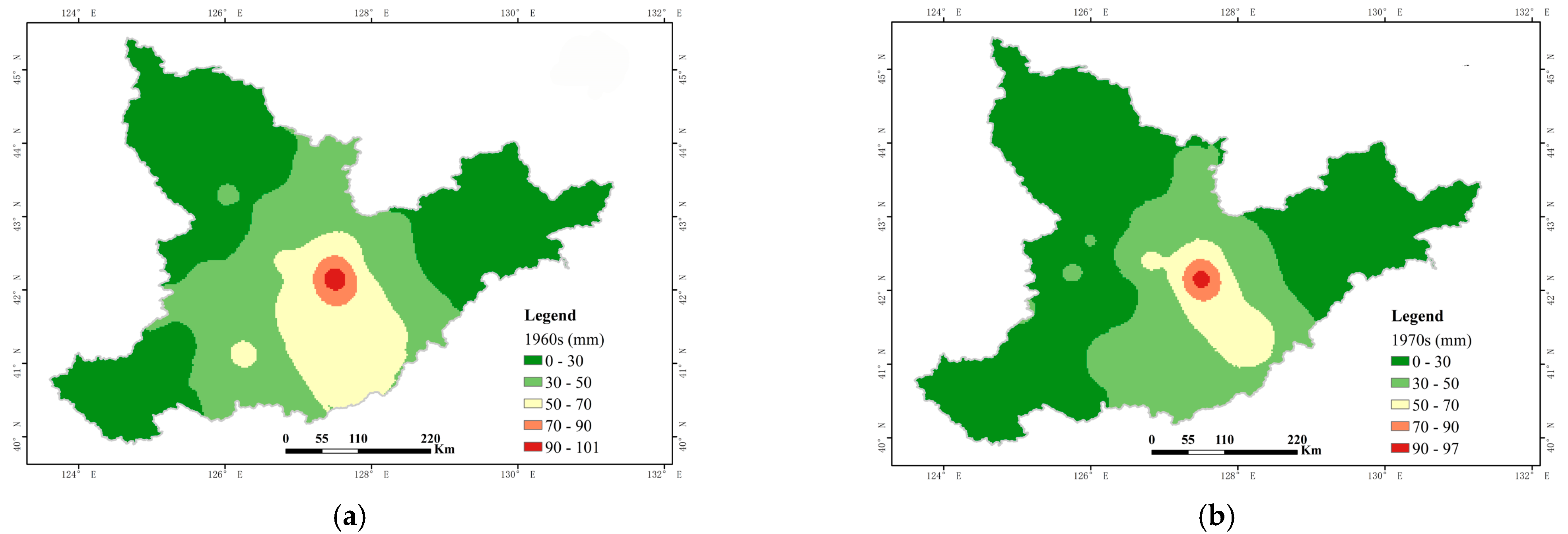
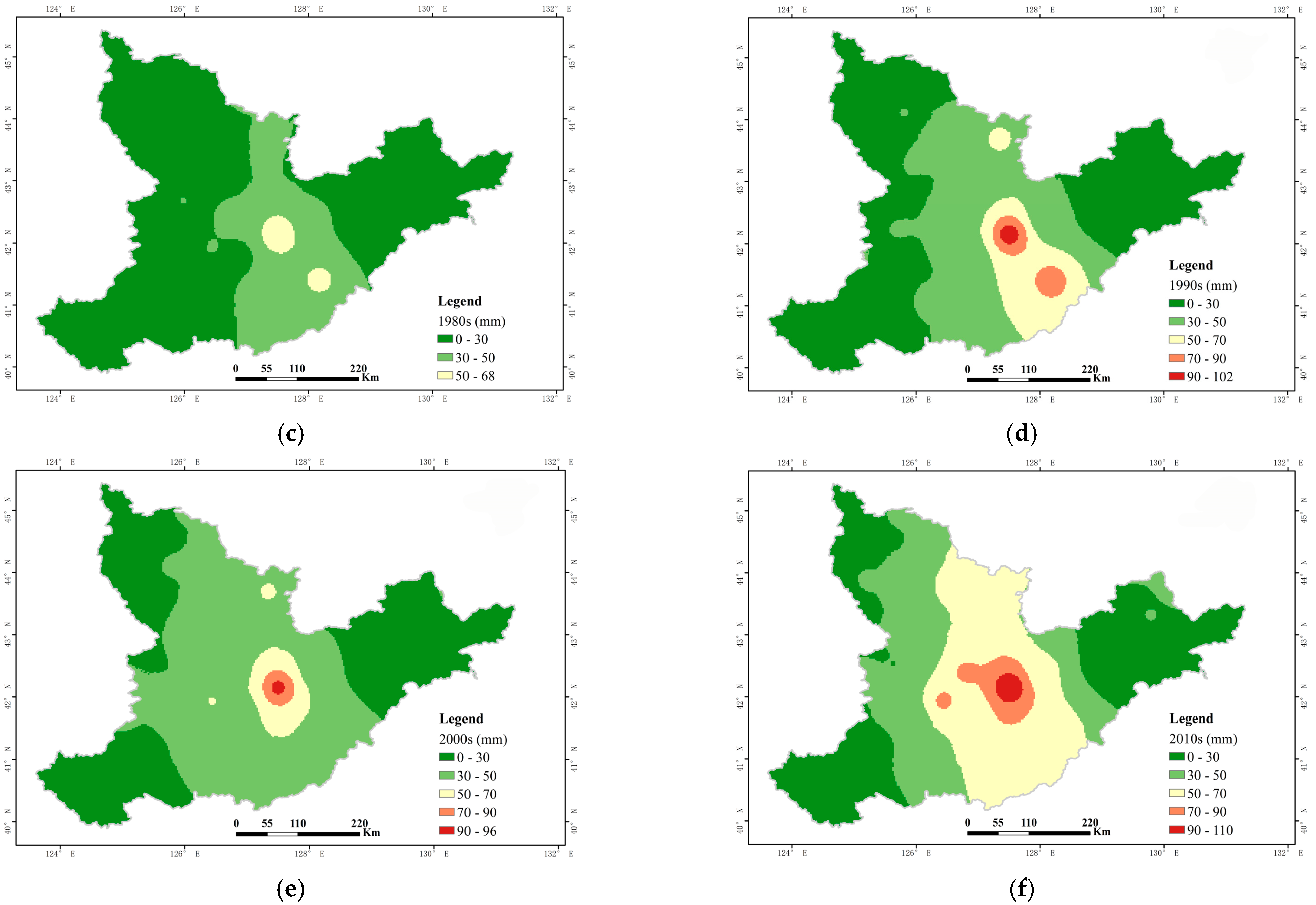
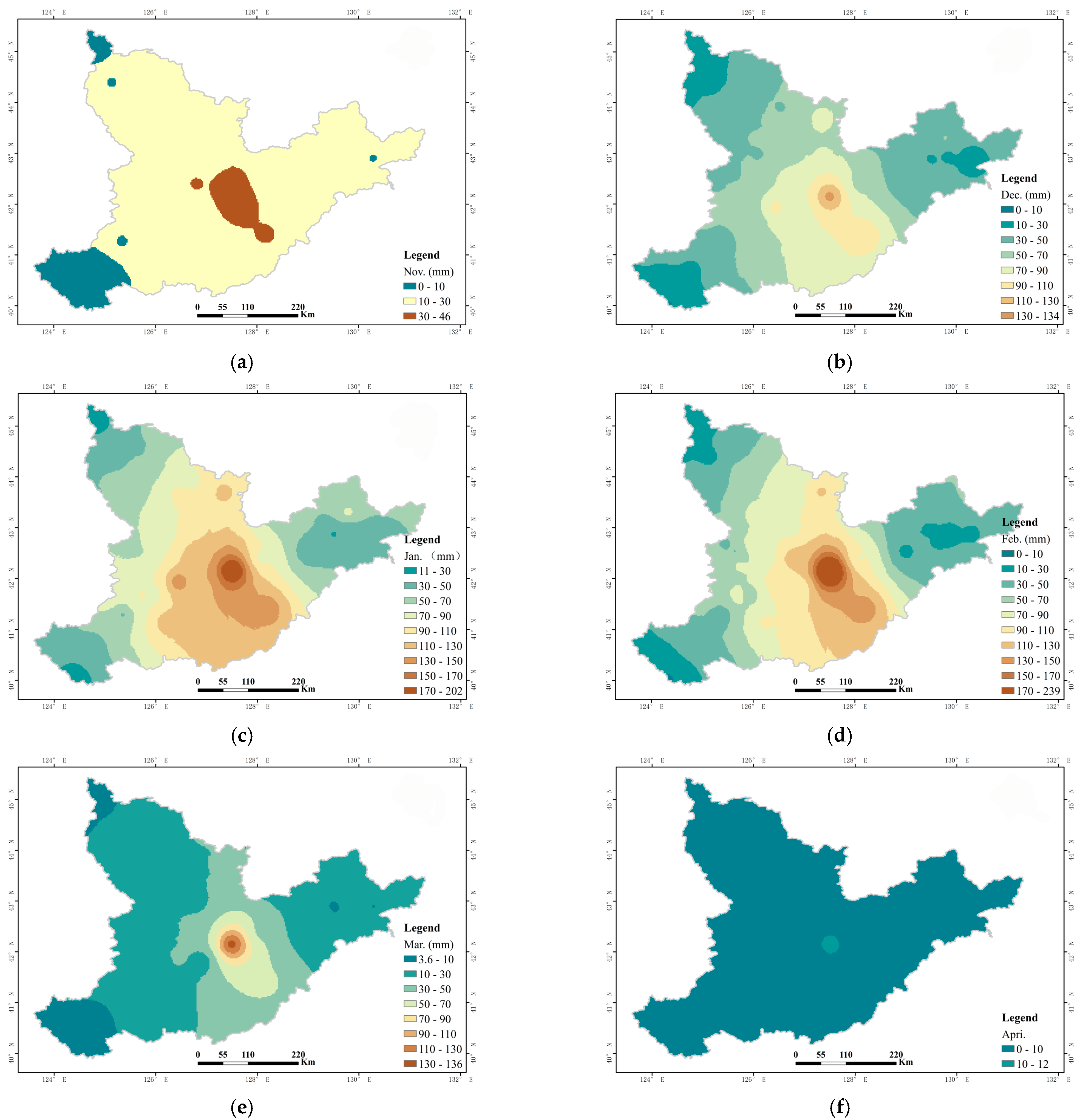
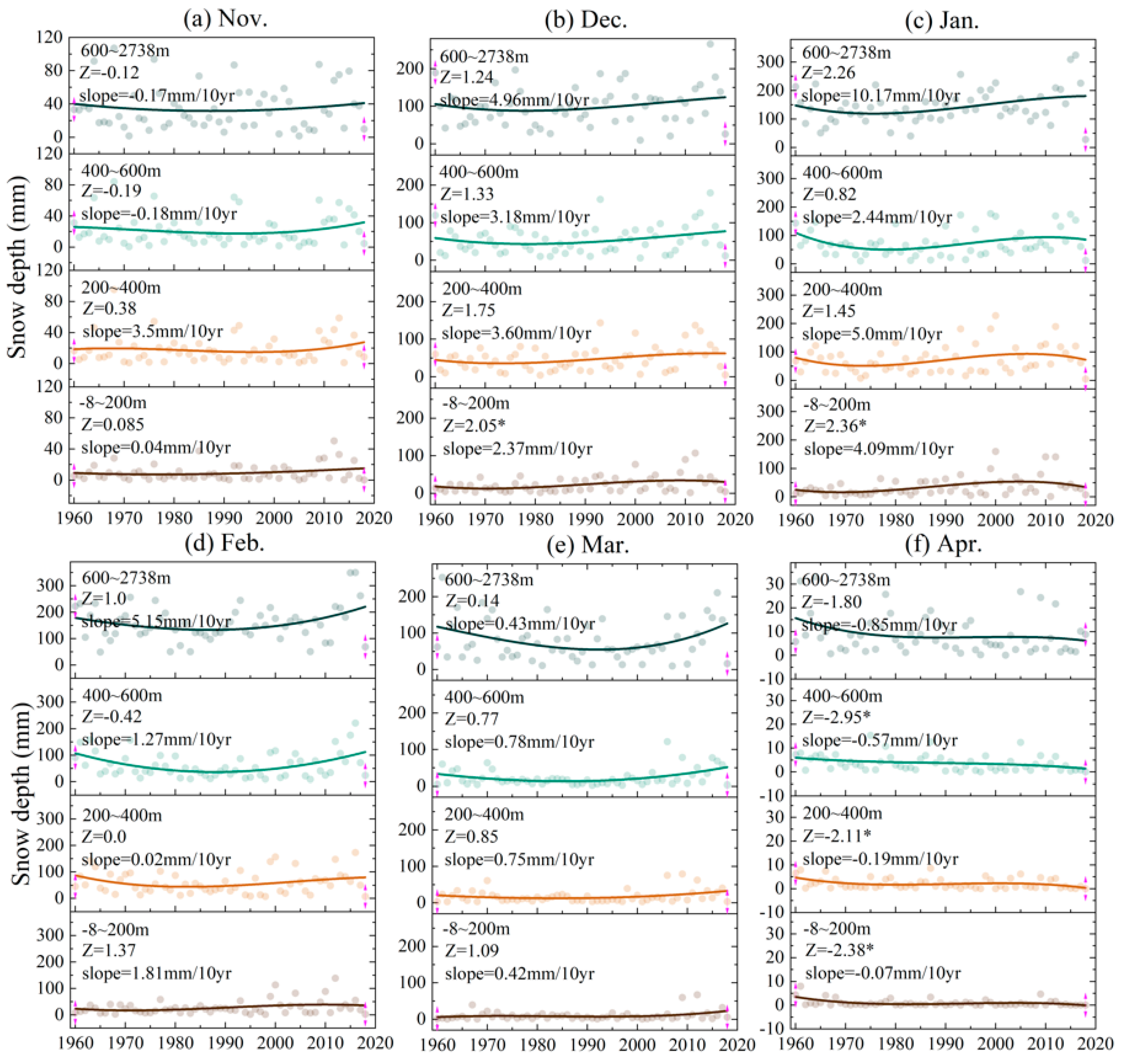
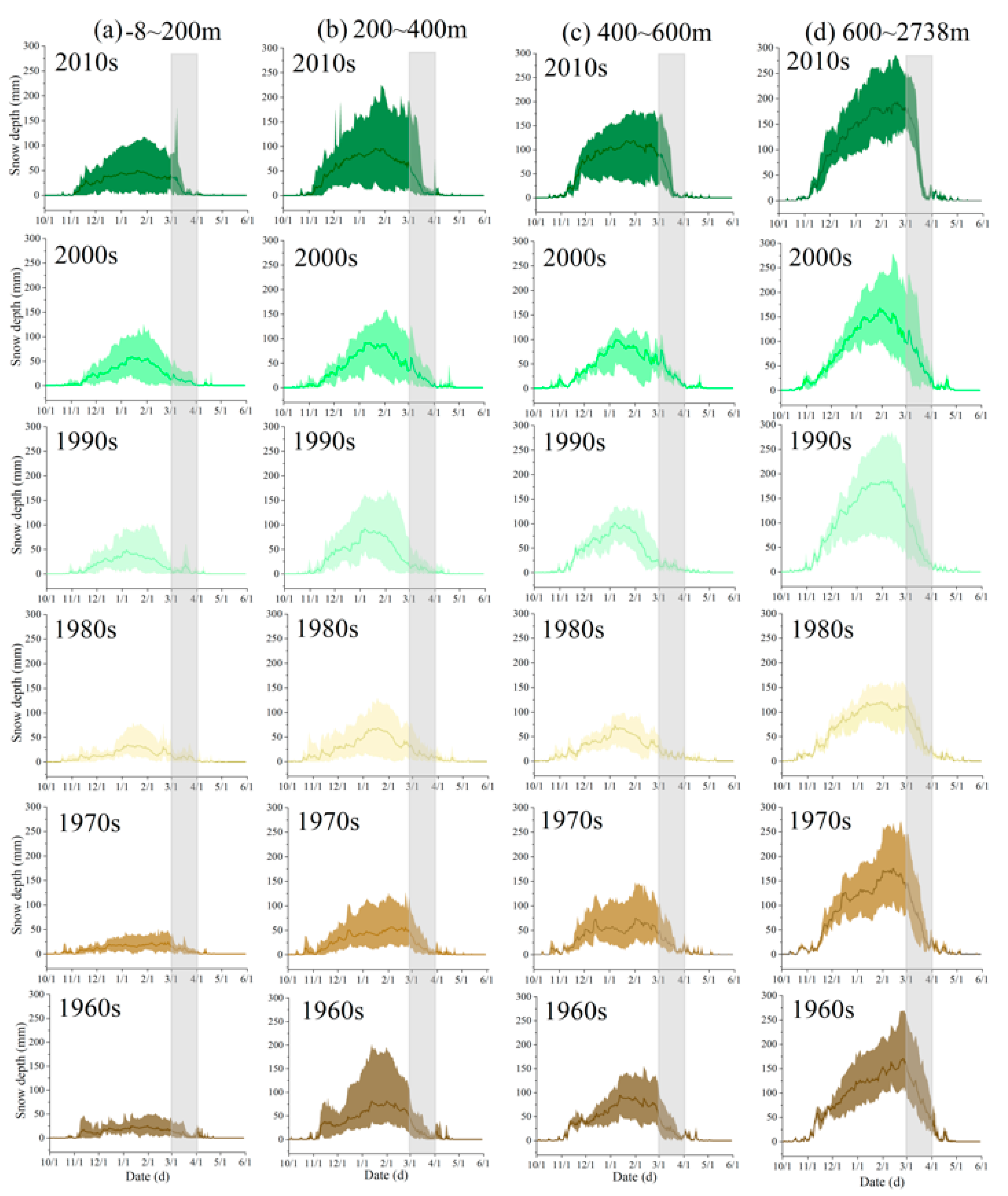
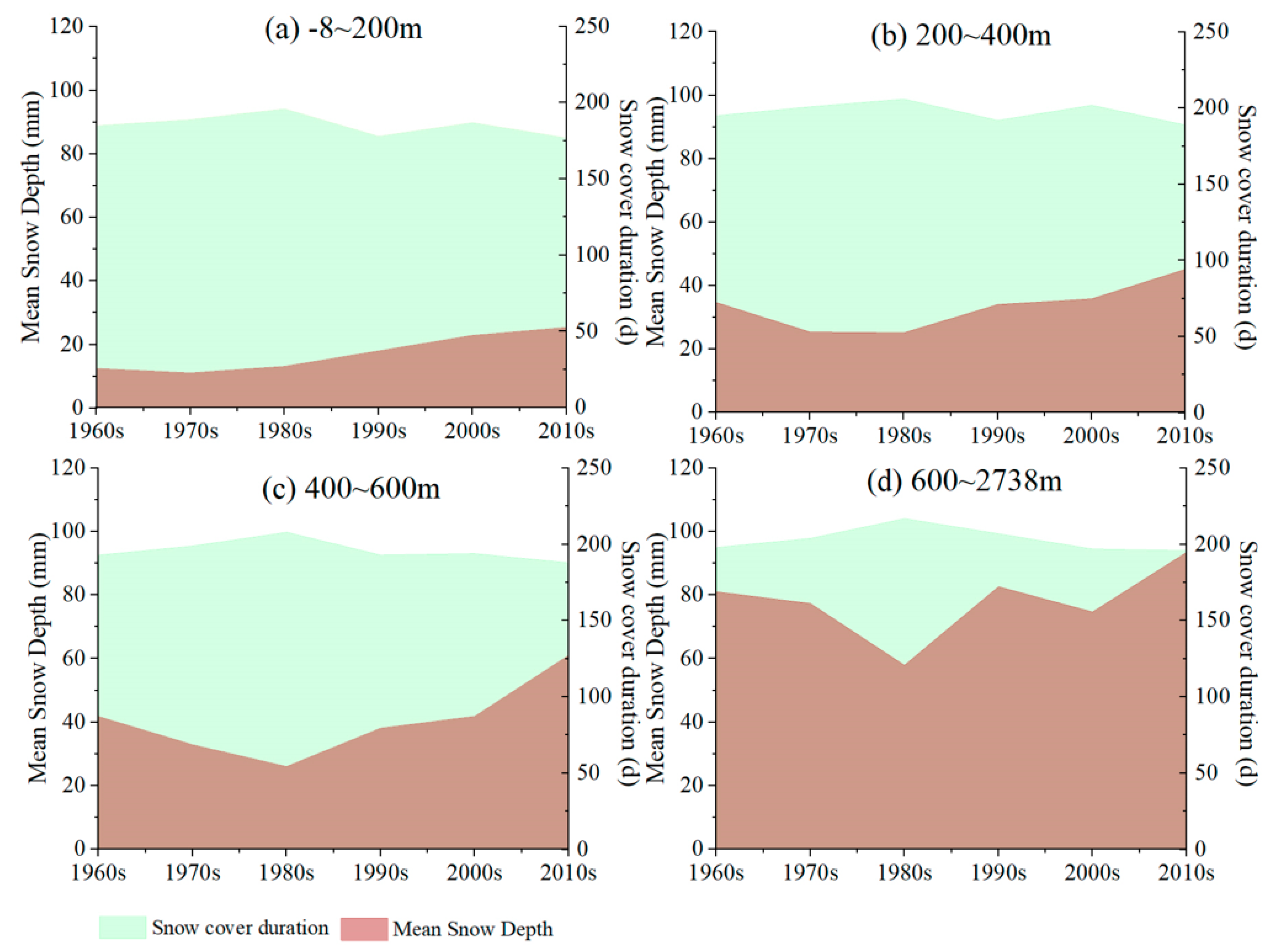
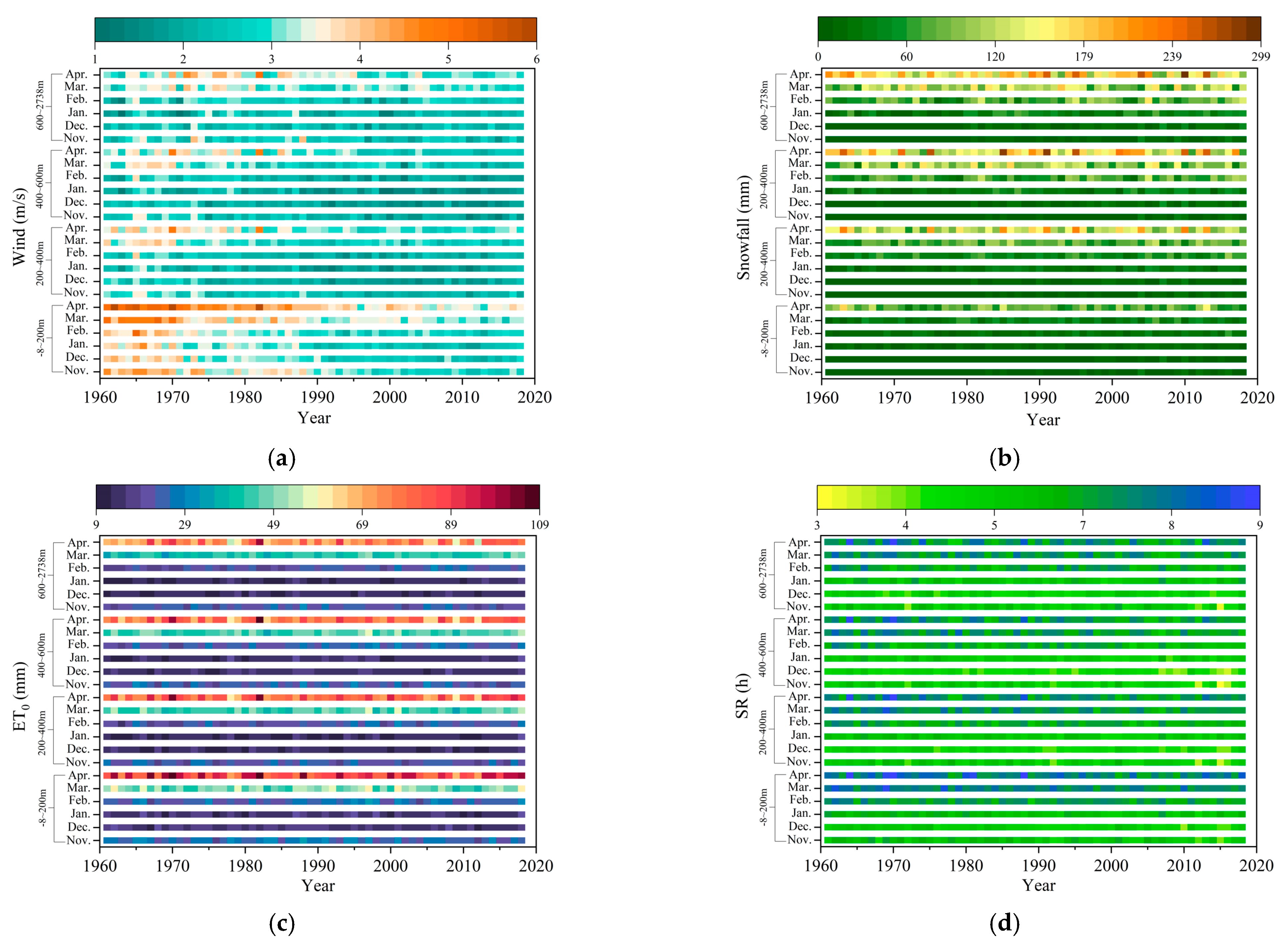
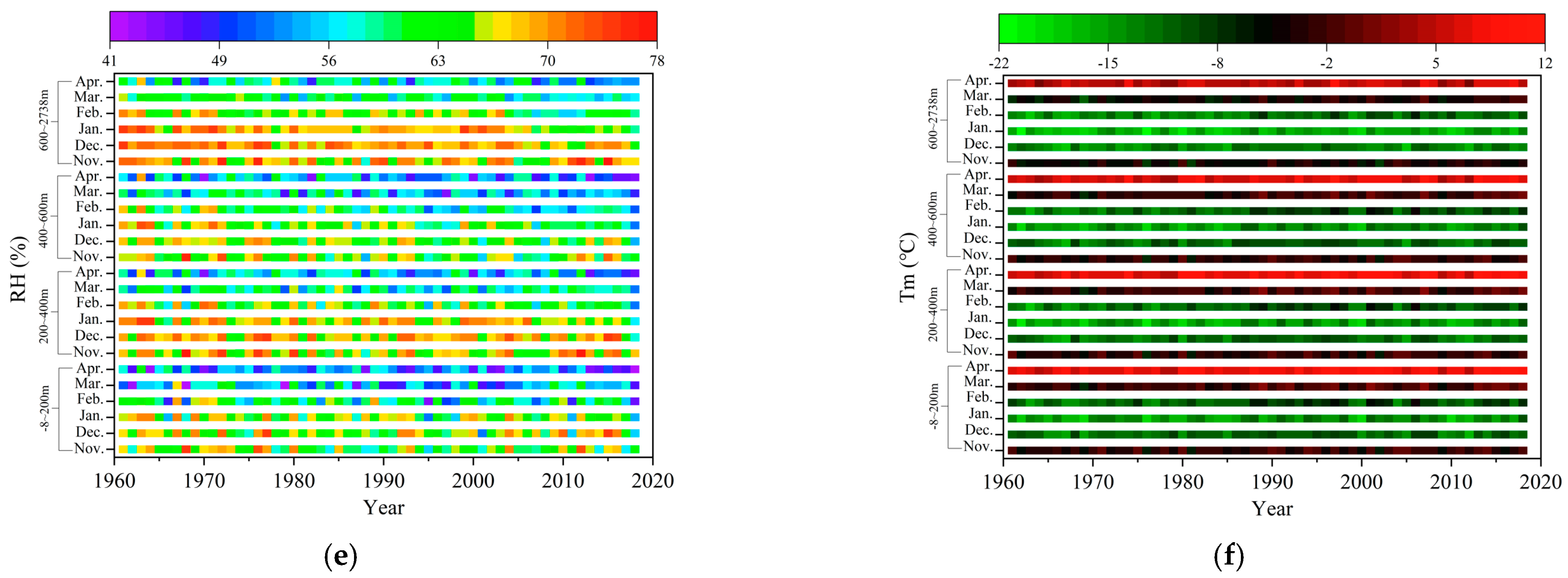
| ID | Code | Altitude (m) | ID | Code | Altitude (m) | ID | Code | Altitude (m) |
|---|---|---|---|---|---|---|---|---|
| 1 | 54590 | 4.2 | 21 | 54483 | 233.6 | 41 | 54263 | 351.2 |
| 2 | 54497 | 13.8 | 22 | 54161 | 236.8 | 42 | 54267 | 362.3 |
| 3 | 54291 | 36.5 | 23 | 54290 | 241.1 | 43 | 54187 | 366.6 |
| 4 | 54494 | 72.6 | 24 | 54195 | 244.8 | 44 | 54374 | 379.7 |
| 5 | 50954 | 127.5 | 25 | 54365 | 245.5 | 45 | 54362 | 380.1 |
| 6 | 50949 | 136.2 | 26 | 54164 | 248.1 | 46 | 54192 | 384.6 |
| 7 | 50946 | 139.8 | 27 | 54260 | 252.9 | 47 | 54363 | 402.9 |
| 8 | 54293 | 142.8 | 28 | 54292 | 257.3 | 48 | 54286 | 475.6 |
| 9 | 50948 | 146.3 | 29 | 54349 | 258.9 | 49 | 54371 | 520.6 |
| 10 | 54065 | 169.1 | 30 | 54493 | 260.1 | 50 | 54186 | 524.9 |
| 11 | 54064 | 170.2 | 31 | 54273 | 263.3 | 51 | 54276 | 570 |
| 12 | 54069 | 173.6 | 32 | 54098 | 267.9 | 52 | 54285 | 721.4 |
| 13 | 54049 | 188.9 | 33 | 54076 | 268.1 | 53 | 54284 | 774.2 |
| 14 | 54072 | 196.5 | 34 | 54169 | 271.6 | 54 | 54386 | 775 |
| 15 | 54063 | 196.8 | 35 | 54172 | 290.3 | |||
| 16 | 54156 | 200.4 | 36 | 54181 | 295 | |||
| 17 | 54165 | 219.5 | 37 | 54274 | 306.7 | |||
| 18 | 54259 | 224 | 38 | 54353 | 328.4 | |||
| 19 | 54377 | 225.1 | 39 | 54266 | 340.5 | |||
| 20 | 54171 | 229.5 | 40 | 54261 | 345.3 |
| Duration | Factors | Edf | F | P | R | Deviance Explained | |
|---|---|---|---|---|---|---|---|
| Nov. | W | 1.00 | 1.00 | 0.32 | 0.00 | 2.03% | |
| SF | 8.58 | 7.16 | 0.00 | 0.57 | 57.50% | *** | |
| ET0 | 1.00 | 51.79 | <2e-16 | −0.47 | 51.50% | *** | |
| SH | 1.00 | 28.94 | 0.00 | −0.32 | 35.10% | *** | |
| RH | 1.00 | 34.34 | 0.00 | 0.35 | 40.60% | *** | |
| Tm | 1.69 | 5.31 | 0.01 | −0.17 | 24.80% | ** | |
| Dec. | W | 1.00 | 11.92 | 0.00 | −0.15 | 19.50% | *** |
| SF | 3.50 | 7.63 | 0.00 | 0.41 | 37.10% | *** | |
| ET0 | 1.00 | 82.74 | <2e-16 | −0.62 | 64.90% | *** | |
| SH | 1.00 | 25.61 | 0.00 | −0.32 | 33.20% | *** | |
| RH | 2.86 | 13.99 | 0.00 | 0.44 | 57.80% | *** | |
| Tm | 1.00 | 17.84 | 0.00 | −0.24 | 23.90% | *** | |
| Jan. | W | 1.00 | 16.08 | 0.00 | −0.19 | 24.70% | *** |
| SF | 1.00 | 6.69 | 0.01 | 0.08 | 12.40% | * | |
| ET0 | 1.36 | 43.03 | <2e-16 | −0.60 | 60.50% | *** | |
| SH | 2.40 | 8.58 | 0.00 | 0.37 | 34.80% | *** | |
| RH | 1.19 | 17.93 | 0.00 | 0.25 | 38.00% | *** | |
| Tm | 1.00 | 19.77 | 0.00 | −0.24 | 26.20% | *** | |
| Feb. | W | 5.34 | 3.40 | 0.01 | −0.23 | 32.90% | ** |
| SF | 1.00 | 0.25 | 0.62 | −0.01 | 0.54% | ||
| ET0 | 1.62 | 23.05 | <2e-16 | −0.45 | 50.80% | *** | |
| SH | 5.38 | 0.75 | 0.60 | −0.03 | 14.70% | ||
| RH | 4.42 | 8.31 | 0.00 | 0.40 | 55.40% | *** | |
| Tm | 1.05 | 8.47 | 0.00 | −0.13 | 16.80% | ** | |
| Mar. | W | 4.64 | 0.76 | 0.61 | −0.02 | 14.50% | |
| SF | 1.167 | 2.81 | 0.11 | 0.04 | 7.48% | ||
| ET0 | 1.19 | 33.83 | <2e-16 | −0.46 | 53.70% | *** | |
| SH | 5.86 | 2.17 | 0.05 | −0.14 | 31.80% | . | |
| RH | 1.00 | 40.39 | <2e-16 | 0.36 | 46.90% | *** | |
| Tm | 4.39 | 2.95 | 0.02 | −0.19 | 30.40% | * | |
| Apr. | W | 3.39 | 0.96 | 0.46 | −0.026 | 11.40% | |
| SF | 4.19 | 2.33 | 0.05 | 0.13 | 28.40% | . | |
| ET0 | 4.426 | 4.36 | 0.00 | −0.28 | 46.90% | ** | |
| SH | 7.76 | 1.47 | 0.20 | −0.10 | 30.60% | ||
| RH | 4.44 | 7.47 | 0.00 | 0.41 | 52.70% | *** | |
| Tm | 1.69 | 8.47 | 0.00 | −0.23 | 39.00% | *** | |
| Duration | Factors | Edf | F | P | R | Deviance Explained | |
|---|---|---|---|---|---|---|---|
| Nov. | W | 1.72 | 0.56 | 0.56 | 0.00 | 4.27% | |
| SF | 2.80 | 1.20 | 0.36 | 0.05 | 9.74% | *** | |
| ET0 | 1.00 | 40.11 | <2e-16 | −0.45 | 46.80% | *** | |
| SH | 2.42 | 7.30 | 0.00 | −0.27 | 32.60% | *** | |
| RH | 1.00 | 50.65 | <2e-16 | 0.51 | 47.60% | *** | |
| Tm | 1.37 | 3.15 | 0.04 | −0.08 | 13.80% | ** | |
| Dec. | W | 1.00 | 7.08 | 0.01 | −0.09 | 12.20% | *** |
| SF | 1.00 | 1.64 | 0.21 | 0.01 | 2.71% | *** | |
| ET0 | 3.42 | 13.91 | <2e-16 | −0.50 | 58.30% | *** | |
| SH | 1.00 | 7.54 | 0.01 | −0.10 | 12.60% | *** | |
| RH | 1.74 | 14.66 | 0.00 | 0.37 | 45.50% | *** | |
| Tm | 1.00 | 9.72 | 0.00 | −0.14 | 14.80% | *** | |
| Jan. | W | 1.00 | 10.24 | 0.00 | −0.14 | 16.30% | *** |
| SF | 1.00 | 4.16 | 0.05 | 0.05 | 7.08% | * | |
| ET0 | 1.00 | 29.64 | 0.00 | −0.35 | 38.30% | *** | |
| SH | 1.04 | 14.24 | 0.00 | −0.21 | 20.80% | *** | |
| RH | 1.00 | 17.36 | 0.00 | 0.21 | 26.50% | *** | |
| Tm | 1.00 | 14.23 | 0.00 | −0.18 | 20.30% | *** | |
| Feb. | W | 4.87 | 0.85 | 0.58 | −0.05 | 12.20% | ** |
| SF | 3.05 | 2.90 | 0.03 | 0.17 | 19.00% | ||
| ET0 | 1.00 | 34.27 | 0.00 | −0.41 | 42.50% | *** | |
| SH | 1.00 | 0.61 | 0.44 | −0.01 | 1.12% | ||
| RH | 1.99 | 11.31 | 0.00 | 0.33 | 41.80% | *** | |
| Tm | 1.00 | 13.84 | 0.00 | −0.21 | 21.50% | ** | |
| Mar. | W | 1.00 | 0.49 | 0.49 | −0.01 | 1.11% | |
| SF | 2.16 | 4.54 | 0.01 | 0.19 | 21.00% | ||
| ET0 | 1.00 | 36.60 | 0.00 | −0.38 | 45.90% | *** | |
| SH | 7.57 | 2.69 | 0.01 | −0.29 | 34.90% | . | |
| RH | 2.70 | 6.81 | 0.00 | 0.25 | 39.60% | *** | |
| Tm | 4.79 | 3.56 | 0.01 | −0.27 | 33.60% | * | |
| Apr. | W | 1.00 | 0.17 | 0.69 | −0.02 | 0.33% | |
| SF | 1.61 | 0.80 | 0.48 | 0.01 | 4.06% | . | |
| ET0 | 2.52 | 9.58 | 0.00 | −0.36 | 42.90% | ** | |
| SH | 1.00 | 3.63 | 0.06 | −0.05 | 7.04% | ||
| RH | 4.58 | 7.93 | 0.00 | 0.47 | 52.10% | *** | |
| Tm | 1.72 | 10.64 | 0.00 | −0.30 | 37.70% | *** | |
| Duration | Factors | Edf | F | P | R | Deviance Explained | |
|---|---|---|---|---|---|---|---|
| Nov. | W | 1.00 | 1.26 | 0.27 | 0.00 | 2.51% | |
| SF | 1.00 | 1.74 | 0.19 | 0.02 | 3.19% | ||
| ET0 | 1.00 | 34.83 | 0.00 | −0.38 | 40.80% | *** | |
| SH | 2.57 | 4.61 | 0.01 | −0.21 | 24.90% | ** | |
| RH | 1.00 | 35.73 | <2e-16 | 0.39 | 39.90% | *** | |
| Tm | 1.28 | 5.30 | 0.01 | −0.12 | 16.80% | * | |
| Dec. | W | 1.00 | 9.26 | 0.00 | −0.13 | 14.60% | ** |
| SF | 1.00 | 0.00 | 0.96 | −0.02 | 0.01% | ||
| ET0 | 1.00 | 21.27 | 0.00 | −0.24 | 29.70% | *** | |
| SH | 1.00 | 2.97 | 0.09 | −0.03 | 5.16% | . | |
| RH | 1.00 | 17.53 | 0.00 | 0.24 | 26.40% | *** | |
| Tm | 1.00 | 1.75 | 0.19 | −0.01 | 3.27% | ||
| Jan. | W | 1.00 | 15.44 | 0.00 | −0.20 | 22.40% | *** |
| SF | 3.23 | 2.06 | 0.10 | 0.11 | 16.20% | . | |
| ET0 | 1.00 | 16.27 | 0.00 | −0.21 | 25.10% | *** | |
| SH | 1.00 | 5.92 | 0.02 | −0.08 | 9.80% | * | |
| RH | 1.00 | 6.51 | 0.01 | 0.09 | 11.40% | * | |
| Tm | 1.66 | 2.35 | 0.11 | −0.06 | 9.86% | ||
| Feb. | W | 5.59 | 2.09 | 0.08 | −0.13 | 25.60% | . |
| SF | 1.00 | 0.56 | 0.46 | −0.01 | 1.12% | ||
| ET0 | 5.03 | 4.05 | 0.00 | −0.29 | 40.20% | ** | |
| SH | 2.34 | 1.00 | 0.39 | −0.03 | 7.48% | ||
| RH | 2.95 | 4.24 | 0.01 | 0.23 | 28.00% | ** | |
| Tm | 1.00 | 7.62 | 0.01 | −0.12 | 14.00% | ** | |
| Mar. | W | 2.53 | 0.65 | 0.55 | −0.01 | 6.93% | |
| SF | 1.77 | 1.23 | 0.32 | 0.03 | 6.68% | ||
| ET0 | 1.00 | 11.52 | 0.00 | −0.14 | 21.70% | ** | |
| SH | 7.64 | 2.65 | 0.02 | −0.28 | 32.20% | * | |
| RH | 2.08 | 3.01 | 0.05 | 0.09 | 20.30% | * | |
| Tm | 7.86 | 2.42 | 0.03 | −0.22 | 37.90% | * | |
| Apr. | W | 1.65 | 0.93 | 0.38 | −0.02 | 5.15% | |
| SF | 1.00 | 2.69 | 0.11 | 0.03 | 4.86% | ||
| ET0 | 1.00 | 27.87 | 0.00 | −0.31 | 33.30% | *** | |
| SH | 1.19 | 2.75 | 0.07 | −0.07 | 8.11% | . | |
| RH | 5.77 | 6.76 | 0.00 | 0.43 | 49.60% | *** | |
| Tm | 1.95 | 16.60 | 0.00 | −0.40 | 46.90% | *** | |
| Duration | Factors | Edf | F | P | R | Deviance Explained | |
|---|---|---|---|---|---|---|---|
| Nov. | W | 1.00 | 1.29 | 0.26 | −0.01 | 2.40% | |
| SF | 1.00 | 0.23 | 0.64 | −0.01 | 0.41% | ||
| ET0 | 1.00 | 28.89 | 0.00 | −0.37 | 37.00% | *** | |
| SH | 1.00 | 14.46 | 0.00 | −0.20 | 22.00% | *** | |
| RH | 1.00 | 24.02 | 0.00 | 0.31 | 31.50% | *** | |
| Tm | 1.00 | 9.40 | 0.00 | −0.13 | 15.10% | ** | |
| Dec. | W | 1.00 | 3.59 | 0.06 | −0.05 | 6.08% | . |
| SF | 1.66 | 0.89 | 0.41 | 0.01 | 4.76% | ||
| ET0 | 2.00 | 2.00 | 0.13 | −0.07 | 11.20% | ||
| SH | 1.03 | 4.63 | 0.04 | −0.06 | 8.03% | * | |
| RH | 1.00 | 6.91 | 0.01 | 0.10 | 11.70% | * | |
| Tm | 1.00 | 0.39 | 0.54 | −0.01 | 0.68% | ||
| Jan. | W | 1.00 | 4.61 | 0.04 | −0.06 | 7.87% | * |
| SF | 1.00 | 1.64 | 0.21 | 0.01 | 2.85% | ||
| ET0 | 1.98 | 0.28 | 0.70 | −0.00 | 4.05% | ||
| SH | 1.00 | 1.46 | 0.23 | −0.01 | 2.63% | ||
| RH | 2.92 | 0.59 | 0.76 | 0.00 | 5.77% | ||
| Tm | 2.88 | 0.81 | 0.46 | −0.03 | 8.31% | * | |
| Feb. | W | 1.00 | 1.23 | 0.27 | −0.00 | 2.21% | |
| SF | 1.00 | 0.05 | 0.82 | −0.02 | 0.09% | ||
| ET0 | 1.00 | 0.84 | 0.36 | −0.00 | 1.54% | ||
| SH | 1.00 | 4.51 | 0.04 | −0.06 | 7.77% | * | |
| RH | 2.27 | 0.81 | 0.41 | 0.02 | 7.21% | ||
| Tm | 1.00 | 0.07 | 0.80 | −0.02 | 0.12% | ||
| Mar. | W | 1.00 | 0.58 | 0.45 | −0.01 | 1.05% | |
| SF | 1.00 | 2.64 | 0.11 | 0.03 | 4.85% | ||
| ET0 | 1.00 | 10.58 | 0.00 | −0.18 | 17.20% | ** | |
| SH | 1.00 | 0.00 | 0.96 | −0.02 | 0.01% | ||
| RH | 1.00 | 3.50 | 0.07 | 0.05 | 6.33% | ||
| Tm | 4.52 | 3.07 | 0.02 | −0.20 | 26.10% | * | |
| Apr. | W | 3.14 | 1.34 | 0.26 | −0.07 | 13.70% | |
| SF | 6.41 | 3.26 | 0.01 | 0.32 | 36.00% | ** | |
| ET0 | 1.00 | 46.51 | <2e−16 | −0.46 | 50.60% | *** | |
| SH | 1.90 | 5.27 | 0.01 | −0.23 | 21.90% | ** | |
| RH | 1.00 | 18.66 | 0.00 | 0.28 | 31.40% | *** | |
| Tm | 1.00 | 76.32 | <2e-16 | −0.62 | 61.40% | *** | |
Publisher’s Note: MDPI stays neutral with regard to jurisdictional claims in published maps and institutional affiliations. |
© 2021 by the authors. Licensee MDPI, Basel, Switzerland. This article is an open access article distributed under the terms and conditions of the Creative Commons Attribution (CC BY) license (https://creativecommons.org/licenses/by/4.0/).
Share and Cite
Chen, Y.; Chang, Z.; Xu, S.; Qi, P.; Tang, X.; Song, Y.; Liu, D. Altitudinal Gradient Characteristics of Spatial and Temporal Variations of Snowpack in the Changbai Mountain and Their Response to Climate Change. Water 2021, 13, 3580. https://doi.org/10.3390/w13243580
Chen Y, Chang Z, Xu S, Qi P, Tang X, Song Y, Liu D. Altitudinal Gradient Characteristics of Spatial and Temporal Variations of Snowpack in the Changbai Mountain and Their Response to Climate Change. Water. 2021; 13(24):3580. https://doi.org/10.3390/w13243580
Chicago/Turabian StyleChen, Yongming, Zehua Chang, Shiguo Xu, Peng Qi, Xiaoyu Tang, Yang Song, and Dongmei Liu. 2021. "Altitudinal Gradient Characteristics of Spatial and Temporal Variations of Snowpack in the Changbai Mountain and Their Response to Climate Change" Water 13, no. 24: 3580. https://doi.org/10.3390/w13243580
APA StyleChen, Y., Chang, Z., Xu, S., Qi, P., Tang, X., Song, Y., & Liu, D. (2021). Altitudinal Gradient Characteristics of Spatial and Temporal Variations of Snowpack in the Changbai Mountain and Their Response to Climate Change. Water, 13(24), 3580. https://doi.org/10.3390/w13243580






